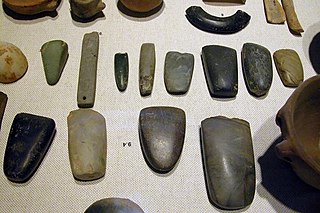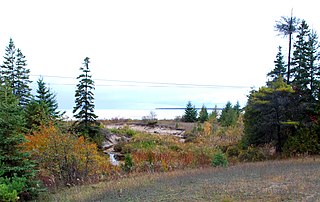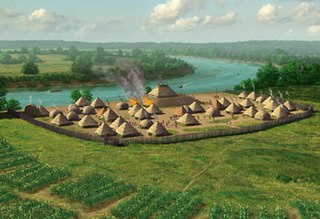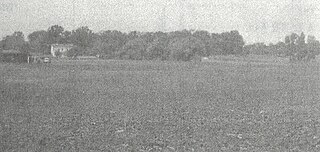
In archaeology, ground stone is a category of stone tool formed by the grinding of a coarse-grained tool stone, either purposely or incidentally. Ground stone tools are usually made of basalt, rhyolite, granite, or other cryptocrystalline and igneous stones whose coarse structure makes them ideal for grinding other materials, including plants and other stones.

Paleoethnobotany, or archaeobotany, is the study of past human-plant interactions through the recovery and analysis of ancient plant remains. Both terms are synonymous, though paleoethnobotany is generally used in North America and acknowledges the contribution that ethnographic studies have made towards our current understanding of ancient plant exploitation practices, while the term archaeobotany is preferred in Europe and emphasizes the discipline's role within archaeology.

Phytoliths are rigid, microscopic structures made of silica, found in some plant tissues and persisting after the decay of the plant. These plants take up silica from the soil, whereupon it is deposited within different intracellular and extracellular structures of the plant. Phytoliths come in varying shapes and sizes. Although some use "phytolith" to refer to all mineral secretions by plants, it more commonly refers to siliceous plant remains. In contrast, mineralized calcium secretions in cacti are composed of calcium oxalates.

This is a list of the National Register of Historic Places listings in Mackinac County, Michigan.

This is a list of the National Register of Historic Places listings in Saginaw County, Michigan.

The Grand Village of the Illinois, also called Old Kaskaskia Village, is a site significant for being the best documented historic Native American village in the Illinois River valley. It was a large agricultural and trading village of Native Americans of the Illinois confederacy, located on the north bank of the Illinois River near the present town of Utica, Illinois. French explorers Louis Joliet and Father Jacques Marquette came across it in 1673. The Kaskaskia, a tribe of the Illiniwek people lived in the village. It grew rapidly after a French mission and fur trading post were established there in 1675, to a population of about 6,000 people in about 460 houses. Around 1691 the Kaskaskia and other Illiniwek moved further south, abandoning the site due to pressure from an Iroquois invasion from the northeast.
Post-excavation analysis constitutes processes that are used to study archaeological materials after an excavation is completed. Since the advent of "New Archaeology" in the 1960s, the use of scientific techniques in archaeology has grown in importance. This trend is directly reflected in the increasing application of the scientific method to post-excavation analysis. The first step in post-excavation analysis should be to determine what one is trying to find out and what techniques can be used to provide answers. Techniques chosen will ultimately depend on what type of artifact(s) one wishes to study. This article outlines processes for analyzing different artifact classes and describes popular techniques used to analyze each class of artifact. Keep in mind that archaeologists frequently alter or add techniques in the process of analysis as observations can alter original research questions.
Leonard Rockshelter, designated 26PE14, is a prehistoric site in the U.S. state of Nevada that was discovered in 1936. It was declared a National Historic Landmark in 1961, qualifying because its well-preserved stratigraphy revealed a long continuum of sporadic cultural occupations from 6710 BC to AD 1400. The site was named after Zenas Leonard, a member of the Bonneville-Walker expedition which passed through the Humboldt Valley in 1833. It was added to the National Register of Historic Places in 1966.
Deborah M. Pearsall is an American archaeologist who specializes in paleoethnobotany. She maintains an online phytolith database. She is a full professor in the Department of Anthropology at the University of Missouri in Columbia, Missouri, where she first began working in 1978. She received her Ph.D. in anthropology from the University of Illinois at Urbana-Champaign in 1979, with a dissertation titled The Application of Ethnobotanical Techniques to the Problem of Subsistence in the Ecuadorian Formative.

Foster's Mound is a Plaquemine culture archaeological site located in Adams County, Mississippi northeast of Natchez off US 61. It is the type site for the Foster Phase of the Natchez Bluffs Plaquemine culture chronology. It was added to the NRHP on September 2, 1982 as NRIS number 82003091. The mounds are listed on the Mississippi Mound Trail.

The Gros Cap Archaeological District is a set of three archaeological sites located in Moran Township, Michigan, USA, designated 20MK6, 20MK7 and 20MK111. It was listed on the National Register of Historic Places in 1982. The three sites cover 13.5 acres (5.5 ha) and include a village site and portions of the Gros Cap Cemetery.

The Juntunen site, also known as 20MK1, is a stratified prehistoric Late Woodland fishing village located on the western tip of Bois Blanc Island. It was listed on the National Register of Historic Places in 1978.

The Horseshoe Lake Mound and Village Site is a pre-Columbian archaeological site located on the northeast shore of Horseshoe Lake in Madison County, Illinois. The site includes a platform temple mound and a village site with the remains of multiple houses. The site was inhabited by Mississippian peoples during the Late Woodland period from roughly 600-1050 A.D. The village at the site was part of the settlement system connected to Cahokia; it was a third line community, a class of community distinguished by a single temple mound, in the system. Of the five known third line communities in the Cahokia system, the Horseshoe Lake Site is the only one which is relatively intact. The site also includes substantial plant and animal remains, which indicate that its settlers produced maize.

The Spoonville site, also designated 20OT1, is a historic archeological site, located on the banks of the Grand River in Crockery Township, Ottawa County, Michigan, United States. It was placed on the National Register of Historic Places in 1973.

The Moccasin Bluff site is an archaeological site located along the Red Bud Trail and the St. Joseph River north of Buchanan, Michigan. It was listed on the National Register of Historic Places in 1977, and has been classified as a multi-component prehistoric site with the major component dating to the Late Woodland/Upper Mississippian period.
The Schmidt Site, also designated 20SA192, is an archaeological site located just south of the Cass River near Bridgeport, Michigan. It was listed on the National Register of Historic Places in 1973.

The Annis Mound and Village site is a prehistoric Middle Mississippian culture archaeological site located on the bank of the Green River in Butler County, Kentucky, several miles northwest of Morgantown in the Big Bend region. It was occupied from about 800 CE to about 1300 CE.
Whittlesey culture is an archaeological designation for a Native American people, who lived in northeastern Ohio during the Late Precontact and Early Contact period between A.D. 1000 to 1640. By 1500, they flourished as an agrarian society that grew maize, beans, and squash. After European contact, their population decreased due to disease, malnutrition, and warfare. There was a period of long, cold winters that would have impacted their success cultivating food from about 1500.

The Knoll Spring site (11Ck-19), aka Au Sagaunashke village, is located in the Sag Valley, Palos Hills, in Cook County, Illinois, near the city of Chicago. It is classified as a late prehistoric site with Upper Mississippian Huber affiliation.
The Oak Forest Site (11Ck-53) is located in Oak Forest, Cook County, Illinois, near the city of Chicago. It is classified as a late prehistoric to Protohistoric/Early Historic site with Upper Mississippian Huber affiliation.

















